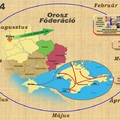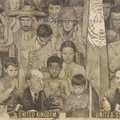Introduction
During the last decades, populist parties, movements and leaders have gained momentum all over the world. Besides Erdogan, Orbán, Trump, Morales and Maduro, Polish populist politician Jarosław Kaczyński is among those leaders, who could make it all the way to the top. Although Kaczyński is neither prime minister nor the president of Poland, he is thought to be one of the de facto leaders of the country.
Cas Mudde (2004) defined populism as ‘an ideology that considers society to be ultimately separated into two homogeneous and antagonistic groups, “the pure people” versus “the corrupt elite”, and which argues that politics should be an expression of the volonté générale (general will) of the people’. Accepting this counter-elite definition of populism, it may seem paradoxical to have a populist ruling elite. To keep their ideology working intact, populist governments need an enemy, against which they could define themselves. After finding appropriate enemies, these governments also need communication channels to reach and convince their constituencies about their ideas. Changes made by Hungarian prime minister Viktor Orbán on the Hungarian media environment served as a roadmap for the ruling party of Poland Law and Justice (Prawo i Sprawiedliwość – PiS) for gaining influence over the state-controlled and private media outlets. In this article, we are going to investigate whether Polish media outlets should be considered as populist entities, and at what level they are under the influence of the governing party.
Polish media can be referred to as populist mouthpieces of the government if all the following conditions are met:
- the Polish government is considered to be populist,
- the Polish media is under the direct supervision of this government, and
- the Polish media spread contents with populist characteristics and/or uses populist rhetoric.
The following chapters are devoted to verifying the presence of these preconditions. First, we examine whether PiS runs a populist government. In the following chapter, we identify the laws and regulations that control the Polish media and the measures implemented by the incumbent government. Finally, we illustrate the populist characteristic of both the state-owned and the government-friendly private Polish media, highlighting some recent examples.
Political background
There are two dominant rivals in the Polish political scene: the right-wing PiS and the center-right Civic Platform (Platforma Obywatelska, PO), both of which are rooted in the socialist era’s Solidarity movement. PO has a liberal approach to economics and is in a well-established relationship with Germany. PiS has a conservative view on abortus, follows a statist view on the economy, supports a more favorable welfare policy, and is more skeptical about the German intentions and the European Union overall. PiS has come to power in 2015 and the next year his nominate Andrzej Duda won the presidential elections. Starting its course, PiS introduced a number of controversial measures, which may violate the European norms. After several warnings, the European Commission (EC) launched a procedure to investigate the rule of law in Poland. In December 2017, the EC triggered article 7 of the European Union treaty on the grounds of a “serious breach” of EU values.
The Guardian initiated cooperation between academics and journalists to create PopuList, in which European parties are collected and categorized as populist, far right, far left and/or Eurosceptic entities. In this listing, PiS is classified as a populist, far-right and Eurosceptic party[1]. Chapel Hill prepares expert surveys that estimate party positioning on various topics. According to the 2019 survey, PiS has a notable anti-elite and anti-establishment rhetoric (on a scale from 0 to 10, experts estimated 9,25 points) with strong leadership control over party policy choices (9,8 points)[2]. According to the report of Tony Blair Institute for Global Change, PiS is a “cultural populist” party[3]. The report defines cultural populism as one that “claims that the true people are the native members of the nation-state, and outsiders can include immigrants, criminals, ethnic and religious minorities, and cosmopolitan elites. Cultural populism tends to emphasize religious traditionalism, law and order, sovereignty, and painting migrants as enemies”.
Considering the above-mentioned surveys and reports, we can call PiS a populist party, which runs a populist government.
Governmental supervision over the Polish media
After winning the election, PiS immediately started to seek control over the public media. Up to that point, the freedom of press was guaranteed by several measures. In the following chapter, we will look at the laws and the measures that were in effect before 2015, and those, which were introduced by PiS after the elections.
The Constitution of the Republic of Poland
The Constitution is the foremost protector of Polish media freedom. As article 14 states, “the Republic of Poland shall ensure freedom of the press and other means of social communication”[4]. Article 54 ensures the freedom to express opinions and disseminate information and prohibits censorship[5].
The press law of 1984
According to the press law of 1984, newspaper publishers are obliged to register in the regional court of the publisher’s domicile. Failing to fulfill the registration the publisher may have to face a fine or a criminal sentence up to 12 months of public service. The press law also stipulates that state entities must provide to the journalists all the required information unless they contain state secrets[6].
The Broadcasting Act of 1992
The Broadcasting Act of 1992 defines the task of radio and television broadcasting as 1.) to provide information; 2.) to ensure access to culture and art; 3.) to facilitate access to learning, sport and scientific achievements; 4.) to disseminate civil education; 5.) to provide entertainment and 6.) to promote domestic production of audiovisual works. It stipulates that the National Broadcasting Council must be established, which “shall constitute the state authority competent in matters of radio and television broadcasting”, and the need “to hold public and open competitions to select members of Supervisory Boards of public radio and television broadcasting organizations”[7].
The “small media law”
Two months after the elections, PiS pushed through the Parliament in two days, and the Polish Senate adopted the so-called “small media law”, which amended the Broadcasting Act of 1992. The new law dismissed the current members of national television and radio broadcasters’ management and supervisory boards. Their positions were filled through direct appointment by the treasury minister, which was a sharp change from the previous practice of open competition. PiS reasoned the change as an effort to depoliticize the public media and rationalize the costs of management. During the next year, 225 journalists were dismissed or resigned[8]. The adoption of the new law met harsh indignation among Polish citizens, prompted countrywide protests, and was also heavily criticized abroad. Even the Polish Constitutional Tribunal found it unconstitutional. However, PiS rejected this ruling, as for that time the “small media law” was superseded by a new legislation.
The “big media law” and the “bridge law”
The ‘small media law” intended only to be a temporary provision followed by a broader set of changes. A bigger and wider media law was on the horizon in 2016. It would have transformed the public media into a “national” media and would have granted more supervisory power to the government over what it should broadcast. Poland’s current deputy minister of culture Krzysztof Czabanski has postponed the implementation of this “big media law”, telling that he wants to take more time to adjust the bill in line with EU law and Council of Europe standards[9].
In the meantime, PiS adopted a less ambitious “bridge law”, to pave the way for the passing of the bigger and wider media law. The Act of June 22 2016 on the National Media Council set up an organization, which has replaced the treasury minister as the nominator of the management and supervisory boards of the public media. Since then, three members of the supervisory board are appointed by the Sejm, while the remaining two are put forward by the opposition and appointed by the president, thus securing the majority of the PiS.
Restricting journalists’ access to the Parliament
In December 2016, PiS government attempted to limit journalists’ access to the Parliament, restricting the allowed number of journalists to two correspondents per outlet and granting the right of recording parliamentary sessions only for five selected television stations. As a consequence of the proposal, 20.000 protesters gathered outside the main public TV station, and subsequent marches spread across the country. While people protested outside the parliament, opposition MPs blocked access to the podium, forcing PiS MPs to vote through the 2017 state budget with a show of hands in another hall. Later the national television aired a 30-minutes film about this incident, calling it an attempt of coup d’état[10]. After the protest, the proposed measures were ultimately withdrawn.
Advertising and distribution
Because of the shrinking advertising market and the growing competition from the direction of the online media, Polish press is highly dependent on the advertising revenue. PiS implemented a support mechanism towards the “friendly” and away from the critical media outlets. It’s not only that the government places advertisements and announcements almost exclusively in the privileged media, but this practice also scares off those state and private companies that want to have a good relationship with the government to put advertisements on the critical to the government outlets.
Limiting the distribution is another tool of the government to make the life of the non-favored publications more complicated. For example, at the state-controlled Orlen petrol stations, it is getting harder to find the Newsweek and Gazeta Wyborcza magazines[11], and at Lotos Paliwa (another state-owned petrol station company), employees were allegedly instructed to make the magazines Do Rzeczy, wSieci, and Gazeta Polska less visible[12].
“Repolonization”
Three-quarters of the Polish printed media and radio outlets are owned by foreign, predominantly German entities (e.g. Bauer Media Group, Verlagsgruppe Passau and Ringier Axel Springer). The famous Rzecpospolita was also owned by Norwegian and British companies before being bought by the Polish Gremi Media in 2011. Minister of Science and Higher Education Jaroslaw Gowin said in comments reported by state-run news agency PAP on June 2019 that “a self-respecting nation and a self-respecting people cannot allow most of the media to be in foreign hands, and this is a task our government faces if we remain in power in the next term”[13]. “Repolonization” of the Polish press would mean in practice to impose a limit on the level of foreign capital in Polish media companies. As Pauline Adès-Mével, the head of Reporters Without Borders’ EU-Balkans desk emphasized, “forcing foreign investors to sell their media outlets poses a grave danger to media pluralism and freedom”[14].
Although the Polish government pulled back the implementation of some of the harshly opposed measures, it still gained significant influence over the local press. The public media outlets are considered now as the mouthpiece of PiS, while the situation of the private sector is notably harder than it was before.
Characteristic and rhetoric of the Polish media
The Reporters Without Borders publishes World Press Freedom Index every year since 2002. It ranks 180 countries based on the evaluation of pluralism, independence of the media, quality of the legislative framework, and safety of journalists. Table 1 shows the ranking of Poland since 2013. Between 2013 and 2015 its position has constantly improved, reaching 18th place in the 180-country sample. After the PiS had come to power and introduced the “small media law”, the country dropped suddenly to the 47th place and kept going down until the 59th place in 2019[15].
| Year | 2013 | 2014 | 2015 | 2016 | 2017 | 2018 | 2019 |
| Ranking | 22/180 | 19/180 | 18/180 | 47/180 | 54/180 | 58/180 | 59/180 |
Table 1: Poland's ranking on the World press freedom index[16]
Freedom House publishes the Freedom in the World global report on political rights and civil liberties annually, composed of numerical ratings and descriptive texts for 195 countries and 15 territories. In the 2020 report, regarding to the freedom and independence of the media, Poland received 3 points out of 4. The report noted that although Poland’s media are pluralistic and mostly privately owned, the public media and their governing bodies have been purged of independent or dissenting voices since PiS came to power in 2015[17].
The Polish media’s choice of topics and their rhetoric are very similar to that can be seen in other populist countries: they cover migrants, George Soros, gay marriage, Euro-scepticism, etc.
One recent example is the state television’s report on the climate change activist Greta Thunberg after she testified at the United Nations. During the report of TVP, they displayed a photograph, in which Greta Thunberg was standing with George Soros, taking it as evidence that she is part of a global conspiracy against PiS. The photo was fake[18].
During the European refugee crisis, PiS had a fiery anti-immigrant rhetoric and the state media supported the government in spreading these ideas. TVP kept accusing recently arrived immigrants for committing attacks against Polish citizens. The television channel often attributed crimes to the immigrants knowing that those claims were grounded on false information[19].
The July 2016 No.29 issue of the right-wing weekly magazine Do Rzeczy was published with the cover headline “Poland against the gay empire: How we protect ourselves against the terror of progressives”, with the photo of conservative journalists Tomasz Terlikowski and Jan Pospieszalski, wearing armors similar to Iron Man’s. In the article, the journal set Christianity against the gay lifestyle.
The abovementioned examples demonstrate that the Polish media outlets (both state-owned and some private ones) have the kind of characteristic, choice of topics and rhetoric that qualifies them to be populists.
Conclusion
In the introductory part, we laid down three preconditions to help us decide whether the Polish media were populist and controlled by the government. These preconditions were:
- the Polish government was considered to be populist,
- the Polish media was under the direct supervision of this government, and
- the Polish media spread contents with populist characteristics and/or used populist rhetoric.
In the previous chapters, we demonstrated that all these three requirements are met in Poland. According to the report of several organizations, the country can be considered to be populist. Although the Polish media is highly polarized, both the state-owned public media and a significant part of the private-owned media are financed and influenced by the PiS government. Analyzing the characteristics and rhetoric of these government-friendly outlets, we can find the same patterns typical to other populist publications. Considering these results, we can conclude that a predominant part of the Polish media is populist, and they are working under the close and direct supervision of PiS.
References:
[1] https://populistorg.files.wordpress.com/2020/02/01-thepopulist.pdf
[2] Ryan Bakker, Liesbet Hooghe, Seth Jolly, Gary Marks, Jonathan Polk, Jan Rovny, Marco Steenbergen, and Milada Anna Vachudova. 2020. “2019 Chapel Hill Expert Survey.” Version 2019.1. Available on chesdata.eu. Chapel Hill, NC: University of North Carolina, Chapel Hill.
[3] https://institute.global/policy/populists-power-around-world
[4] http://www.sejm.gov.pl/prawo/konst/angielski/kon1.htm
[5] Ibid.
[6] https://edri.org/edrigramnumber9-1polish-electronic-press-registration-compulsory/
[7]http://www.krrit.gov.pl/Data/Files/_public/Portals/0/angielska/Documents/Regulations/broadcasting_act_28022013.pdf
[8]https://freedomhouse.org/sites/default/files/2020-02/FH_Poland_Media_Report_Final_2017.pdf
[9] https://euobserver.com/political/133761
[10] https://www.youtube.com/watch?v=39bAPEPqtBc
[11]http://www.wirtualnemedia.pl/artykul/tomasz-lis-newsweek-i-gazeta-wyborcza-sa-chowane-na-stacjach-orlen-agora-z-rozwiazana-umowa-na-ekspozycje-tytulow
[12] http://biznes.trojmiasto.pl/Ulubione-gazety-klientow-stacji-Lotosu-n108873.html
[13]https://www.reuters.com/article/us-poland-media/polish-government-to-repolonize-media-in-next-term-deputy-pm-says-idUSKCN1TL1EX
[14] https://rsf.org/en/news/polands-plan-repolonize-foreign-owned-media
[15] https://rsf.org/en/poland
[16] Ibid.
[17] https://freedomhouse.org/country/poland/freedom-world/2020
[18] https://www.nytimes.com/2019/10/11/world/europe/poland-election-state-television-tvp.html
[19]https://oko.press/wiadomosci-tvp-morduja-uchodzcy-fakty-maja-znaczenia/?fbclid=IwAR097gUE1-cPbuzWebeBM2txQ0w5oEIRhqjyxeL4ij395zcXFUt-QHjZ2gg





